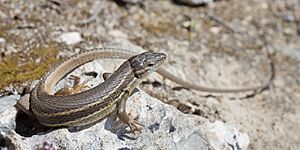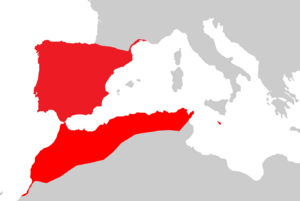Psammodromus algirus facts for kids
Quick facts for kids Psammodromus algirus |
|
|---|---|
 |
|
| Conservation status | |
| Scientific classification | |
 |
|
| Range | |
| Synonyms | |
|
Psammodromus algirus, known commonly as the Algerian psammodromus or the large psammodromus, is a species of lizard in the family Lacertidae. The species is found in southwestern Europe and northwestern Africa.
Subspecies
There are four subspecies:
- Psammodromus algirus algirus (Linnaeus, 1758)
- Psammodromus algirus doriae Bedriaga, 1886
- Psammodromus algirus nollii Fischer, 1887
- Psammodromus algirus ketamensis Galán, 1931
Geographic range
Psammodromus algirus is found in North Africa (Morocco, Algeria, and Tunisia) and in Southwestern Europe (Iberian Peninsula: Portugal, Spain, Andorra, Gibraltar; southernmost France, and Italy near Lampedusa).
The IUCN assessment from 2009 treats Psammodromus algirus nollii and Psammodromus algirus ketamensis as full species and restricts Psammodromus algirus to North Africa.
Habitat
P. algirus typically occurs in dense bushy vegetation, but it can also venture to more open areas. It can be found at at elevations up to 2,600 m (8,500 ft) above sea level, but it is more common at lower elevations.
Diet
Psammodromus algirus mainly feeds on terrestrial arthropods, specifically Orthoptera, Formicidae, Coleoptera, Hemiptera, and Araneae.
Conservation status
P. algirus is threatened by habitat loss.
Description
P. algirus commonly reaches a snout–vent length of about 7.5 cm (3.0 in), occasionally 9 cm (3.5 in). The tail is 2–3 times the body length. Dorsal colouration is usually metallic brownish with a pair of conspicuous white or yellowish stripes on both sides.


